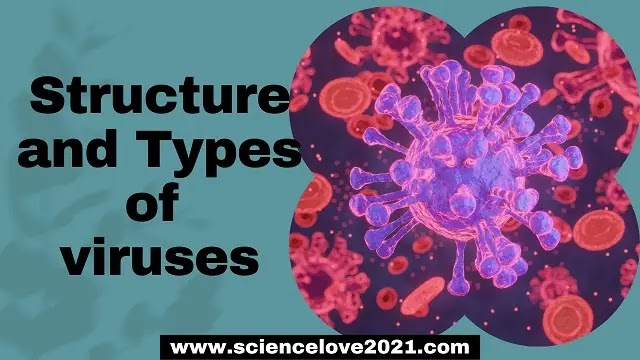Structure and Types of Viruses
Many things are found in the structure of the Viruses, which are described as follows.
(i) Size - The size of viruses cannot measured by ordinary microscopy. But now techniques like ultracentrifugation and electron microscopy can be measured. Viruses are very small in size ranging from 20-350 nm. The 7The complex bacteriophages are about 65 nm x 200 nm. The smallest viruses known are less than 30 nm in diameter.
(ii) Shape - Shape of viruses are Helical rod viruses e.g. New castle virus, Mumps virus, Tobacco mosaic virus, cuboid viruses example- Herpes virus, Turnip yellow mosaic virus, Polyoma virus, Ф x 174 viruses. Complex viruses, Influenza virus. Tadpole-like viruses e.g. bacteriophage.
(iii) Nucleic acid - They contain only one type of nucleic acid which may be either DNA or RNA. The viruses containing DNA are called Deoxy viruses while viruses containing RNA are called Ribo viruses. In general-
- All plant viruses have single-stranded RNA.
- Animal viruses consist of either single or (rarely) double-stranded RNA or double-stranded DNA.
- Bacterial viruses contain mostly double-stranded DNA but can also have single-stranded DNA or RNA.
- Most insect viruses contain RNA and only a few have DNA. The DNA of some bacterial and animal viruses is circular, but in others, it is like RNA.
(iv) Protein coat - Nucleic acid covered by a protein coat called Capsid. Each capsid consists of several identical protein subunits called capsomeres. In some viruses, the proteins composing the capsomeres are of a single type while in others several types of proteins may be present. These subunits are usually arranged in the helical or polyhedral geometric forms. The number of proteins and the arrangement of viral capsomeres are characteristic of specific viruses. Capsomeres forming the capsid 'protein coat' of a virion are two types:
1. Pentamer - It is made of five identical monomers.
2. Hexamer - It is made of six monomers.
Each monomer is connected with neighboring monomers on either side with the help of bonds. In some complex forms like influenza and herpes virus. The capsid is covered by an envelope. It usually consists of some combination of lipids, proteins, and carbohydrates. Some animal viruses, which are released from the host cell by an extrusion process, get coated by the host cell's plasma membrane. This membrane eventually becomes the viral envelope.
Types of Viruses
Depending upon their host, the viruses are classified as -1. Bacteriophages - Viruses that parasitize bacteria are called bacteriophages or phages. The phages may be spherical or comma-shaped but the majority of them have a tadpole-like appearance.
2. Animal Viruses - Animal viruses live inside animal cells including man. On entering the cell, these disturb the metabolism of the host cell and cause viral diseases such as smallpox, chicken pox, rabies, poliomyelitis, mumps, measles, influenza, hepatitis, and common cold. Certain leukemia and cancers are also caused by viruses. Such viruses are called reoviruses and Oncoviruses.
3. Plant Viruses (Phytophages) - These are parasites on plant cells. The common plant viruses are tobacco mosaic virus (TMV), tobacco rattle virus (TRV), potato virus, southern bean mosaic virus (SBMV), beat yellow virus (BYV), and turnip yellow virus (TYV). The tobacco mosaic virus was the first virus to be discovered. It was recognized by Iwanowski (1892) and was isolated in crystalline form by Stanley (1936). It is in the form of a cylindrical rod measuring 16 x 300 nm. Its RNA is a single-stranded, helical molecule. The protein coat consists of 2130 capsomeres.
4. Cynophages - These are parasites of blue-green algae.
5. Mycophages - These are parasites of fungal cells.



No comments:
Post a Comment